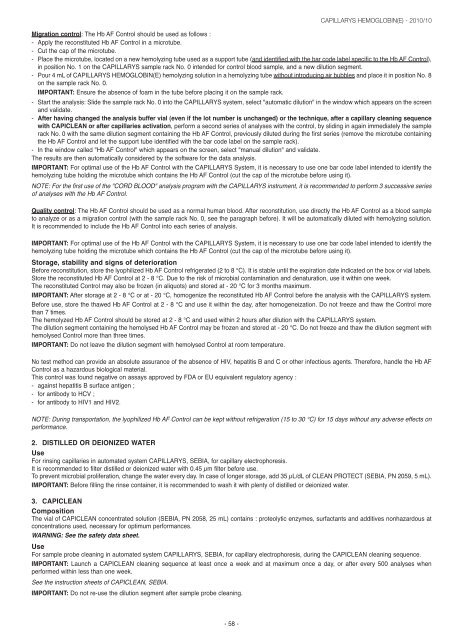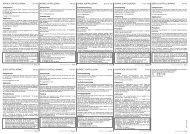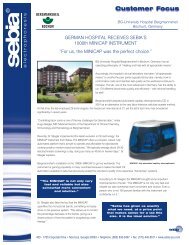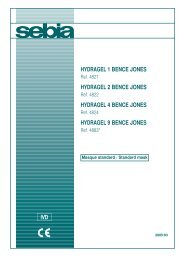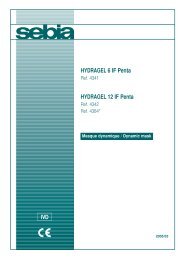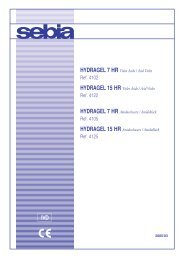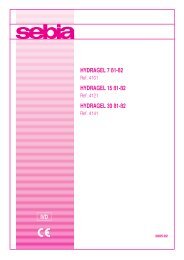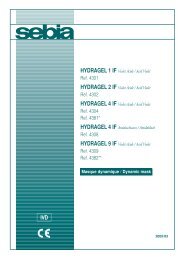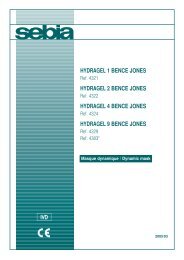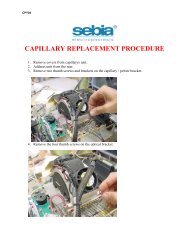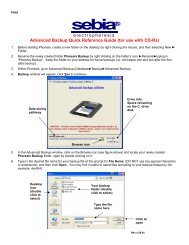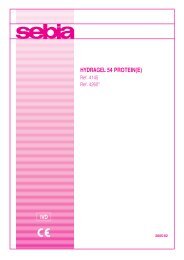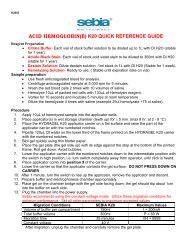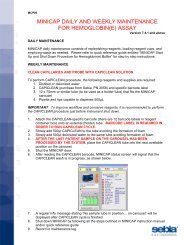CAPILLARYS HEMOGLOBIN(E)
CAPILLARYS HEMOGLOBIN(E) - Sebia Electrophoresis
CAPILLARYS HEMOGLOBIN(E) - Sebia Electrophoresis
- No tags were found...
You also want an ePaper? Increase the reach of your titles
YUMPU automatically turns print PDFs into web optimized ePapers that Google loves.
<strong>CAPILLARYS</strong> <strong>HEMOGLOBIN</strong>(E) - 2010/10<br />
Migration control: The Hb AF Control should be used as follows :<br />
- Apply the reconstituted Hb AF Control in a microtube.<br />
- Cut the cap of the microtube.<br />
- Place the microtube, located on a new hemolyzing tube used as a support tube (and identified with the bar code label specific to the Hb AF Control),<br />
in position No. 1 on the <strong>CAPILLARYS</strong> sample rack No. 0 intended for control blood sample, and a new dilution segment.<br />
- Pour 4 mL of <strong>CAPILLARYS</strong> <strong>HEMOGLOBIN</strong>(E) hemolyzing solution in a hemolyzing tube without introducing air bubbles and place it in position No. 8<br />
on the sample rack No. 0.<br />
IMPORTANT: Ensure the absence of foam in the tube before placing it on the sample rack.<br />
- Start the analysis: Slide the sample rack No. 0 into the <strong>CAPILLARYS</strong> system, select "automatic dilution" in the window which appears on the screen<br />
and validate.<br />
- After having changed the analysis buffer vial (even if the lot number is unchanged) or the technique, after a capillary cleaning sequence<br />
with CAPICLEAN or after capillaries activation, perform a second series of analyses with the control, by sliding in again immediately the sample<br />
rack No. 0 with the same dilution segment containing the Hb AF Control, previously diluted during the first series (remove the microtube containing<br />
the Hb AF Control and let the support tube identified with the bar code label on the sample rack).<br />
- In the window called "Hb AF Control" which appears on the screen, select "manual dilution" and validate.<br />
The results are then automatically considered by the software for the data analysis.<br />
IMPORTANT: For optimal use of the Hb AF Control with the <strong>CAPILLARYS</strong> System, it is necessary to use one bar code label intended to identify the<br />
hemolyzing tube holding the microtube which contains the Hb AF Control (cut the cap of the microtube before using it).<br />
NOTE: For the first use of the "CORD BLOOD" analysis program with the <strong>CAPILLARYS</strong> instrument, it is recommended to perform 3 successive series<br />
of analyses with the Hb AF Control.<br />
Quality control: The Hb AF Control should be used as a normal human blood. After reconstitution, use directly the Hb AF Control as a blood sample<br />
to analyze or as a migration control (with the sample rack No. 0, see the paragraph before). It will be automatically diluted with hemolyzing solution.<br />
It is recommended to include the Hb AF Control into each series of analysis.<br />
IMPORTANT: For optimal use of the Hb AF Control with the <strong>CAPILLARYS</strong> System, it is necessary to use one bar code label intended to identify the<br />
hemolyzing tube holding the microtube which contains the Hb AF Control (cut the cap of the microtube before using it).<br />
Storage, stability and signs of deterioration<br />
Before reconstitution, store the lyophilized Hb AF Control refrigerated (2 to 8 °C). It is stable until the expiration date indicated on the box or vial labels.<br />
Store the reconstituted Hb AF Control at 2 - 8 °C. Due to the risk of microbial contamination and denaturation, use it within one week.<br />
The reconstituted Control may also be frozen (in aliquots) and stored at - 20 °C for 3 months maximum.<br />
IMPORTANT: After storage at 2 - 8 °C or at - 20 °C, homogenize the reconstituted Hb AF Control before the analysis with the <strong>CAPILLARYS</strong> system.<br />
Before use, store the thawed Hb AF Control at 2 - 8 °C and use it within the day, after homogeneization. Do not freeze and thaw the Control more<br />
than 7 times.<br />
The hemolyzed Hb AF Control should be stored at 2 - 8 °C and used within 2 hours after dilution with the <strong>CAPILLARYS</strong> system.<br />
The dilution segment containing the hemolysed Hb AF Control may be frozen and stored at - 20 °C. Do not freeze and thaw the dilution segment with<br />
hemolysed Control more than three times.<br />
IMPORTANT: Do not leave the dilution segment with hemolysed Control at room temperature.<br />
No test method can provide an absolute assurance of the absence of HIV, hepatitis B and C or other infectious agents. Therefore, handle the Hb AF<br />
Control as a hazardous biological material.<br />
This control was found negative on assays approved by FDA or EU equivalent regulatory agency :<br />
- against hepatitis B surface antigen ;<br />
- for antibody to HCV ;<br />
- for antibody to HIV1 and HIV2.<br />
NOTE: During transportation, the lyophilized Hb AF Control can be kept without refrigeration (15 to 30 °C) for 15 days without any adverse effects on<br />
performance.<br />
2. DISTILLED OR DEIONIZED WATER<br />
Use<br />
For rinsing capillaries in automated system <strong>CAPILLARYS</strong>, SEBIA, for capillary electrophoresis.<br />
It is recommended to filter distilled or deionized water with 0.45 µm filter before use.<br />
To prevent microbial proliferation, change the water every day. In case of longer storage, add 35 µL/dL of CLEAN PROTECT (SEBIA, PN 2059, 5 mL).<br />
IMPORTANT: Before filling the rinse container, it is recommended to wash it with plenty of distilled or deionized water.<br />
3. CAPICLEAN<br />
Composition<br />
The vial of CAPICLEAN concentrated solution (SEBIA, PN 2058, 25 mL) contains : proteolytic enzymes, surfactants and additives nonhazardous at<br />
concentrations used, necessary for optimum performances.<br />
WARNING: See the safety data sheet.<br />
Use<br />
For sample probe cleaning in automated system <strong>CAPILLARYS</strong>, SEBIA, for capillary electrophoresis, during the CAPICLEAN cleaning sequence.<br />
IMPORTANT: Launch a CAPICLEAN cleaning sequence at least once a week and at maximum once a day, or after every 500 analyses when<br />
performed within less than one week.<br />
See the instruction sheets of CAPICLEAN, SEBIA.<br />
IMPORTANT: Do not re-use the dilution segment after sample probe cleaning.<br />
- 58 -


